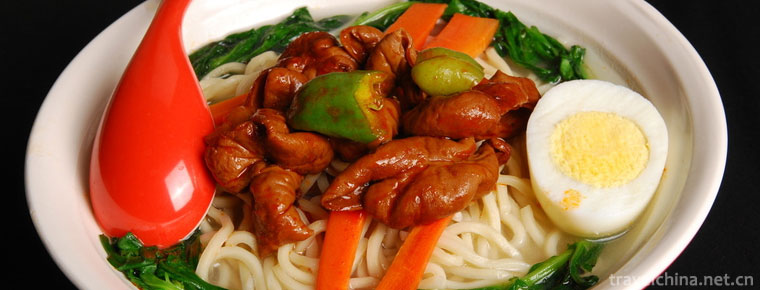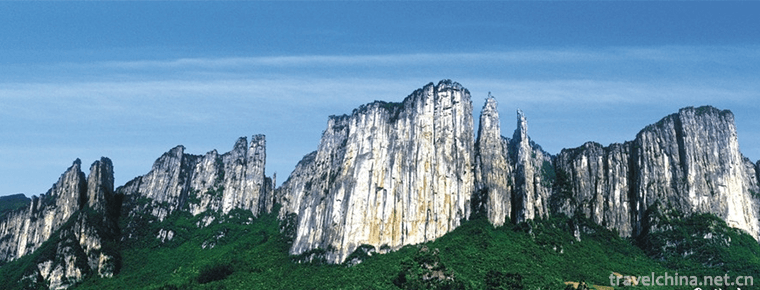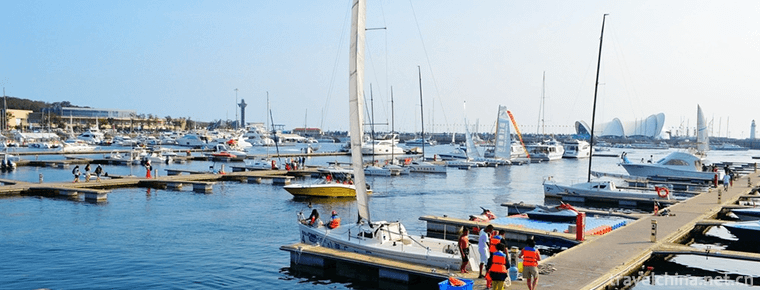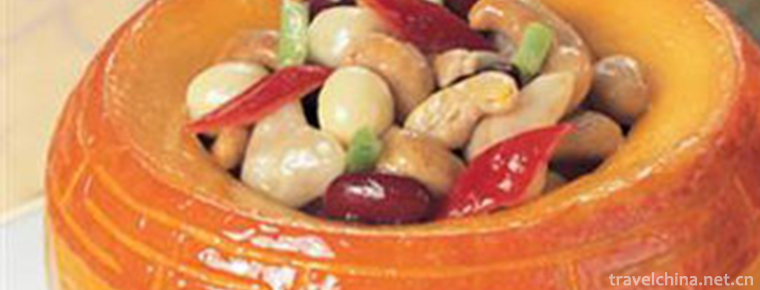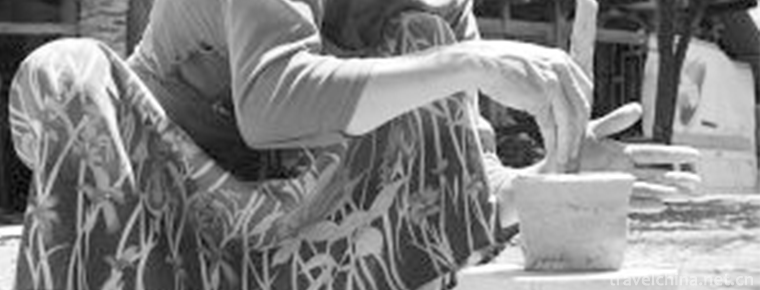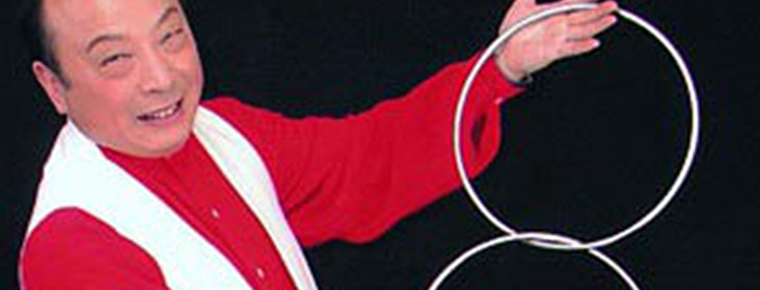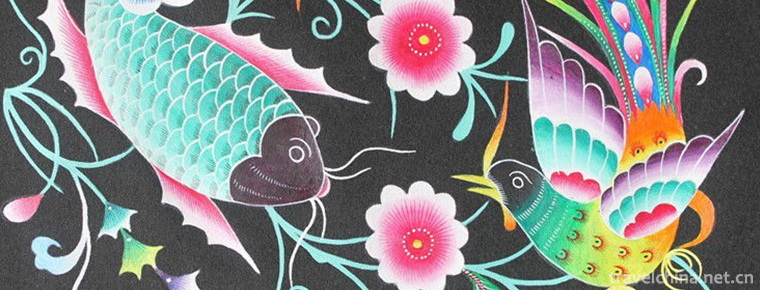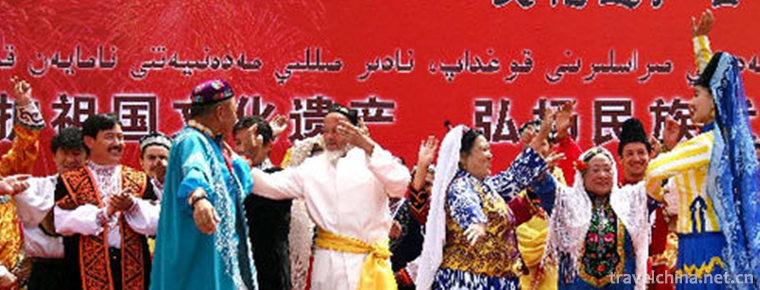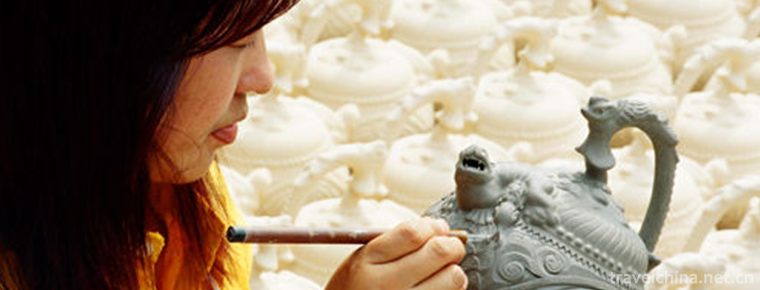Skills of Dry Lacquer and Ramie in Tiantai Mountains
Skills of Dry Lacquer and Ramie in Tiantai Mountains
Tiantai Mountain dry lacquer with ramie, traditional handicraft in Tiantai County, Taizhou City, Zhejiang Province, is one of the national intangible cultural heritage.
As early as the Eastern Jin Dynasty, dry lacquer and ramie had been used in Tiantai folk. Through the continuous efforts of the substitute craftsmen, their skills gradually matured. In the mid-Tang Dynasty, Sito, a monk, used this legal system to make a sitting image of Jianzhen in Japan, which was regarded as a national treasure by Japan. The technology of dry lacquer and ramie in Tiantai Mountain has a history of more than 1,800 years, and it has a unique technological process and production techniques. This technique uses natural raw materials, and combines sculpture, lacquer, ramie and other crafts in the same work, with distinctive features.
On May 20, 2006, the dry lacquer and Ramie Technology of Tiantai Mountain was approved by the State Council and listed in the first batch of national intangible cultural heritage list, item number_-53.
As early as the Eastern Jin Dynasty, dry lacquer with ramie has been used in Tiantai folk. According to historical records, in the Eastern Jin Dynasty, Dai Kui (336-396) and his son used the folk "dry lacquer and ramie method" to make Buddha statues in monasteries and made wooden carvings of "dry lacquer and ramie" Buddha statues. For thousands of years, through successive generations of artisans'continuous inheritance and innovation, dry lacquer and ramie technology has gradually matured and spread to the surrounding areas of the roof. In the mid-Tang Dynasty, the Buddhist monk Situo introduced this method to Japan. At that time, the Jianzhen sitting statue made by him was regarded as a national treasure by Japan. In the Song Dynasty (984 A.D.), a statue of Sakyamuni, a volt-filling king, was brought back to Japan by Japanese monks and worshipped in the Qingliang Temple by Zhang Yanhao and Zhang Yanqiu brothers from Tiantai. Legend has it that Zhang Wenyu, a Tiantai man in Ming Dynasty, was instructed to supervise the construction of the Beijing Palace Museum. He invited a group of craftsmen of dry lacquer and ramie craftsmanship to decorate the palace's algae entry, columns and beams.
As the "dry lacquer with ramie" technology has been limited to the inheritance of folk craftsmen, the transfer of skills relies on the oral and personal instruction of teachers and apprentices, without the formation of words, only by understanding and long-term practice experience to master. Historically, a large scale of production has not been formed. Before liberation, due to the continuous war and the lack of livelihood among the people, the folk craftsmen of dry lacquer and ramie changed their professions, which made the technology almost lost. At the beginning of liberation, only a few folk craftsmen were familiar with this method.
In the 1980s, Tang Chunfu, a senior craftsman, organized craftsmen to excavate and sort out the dried lacquer and Ramie Technology scattered among the people, which was on the verge of being lost. Thirteen raw materials used in this technology were extracted by traditional methods, and 48 technological processes were summarized, which made this ancient traditional technology glow with new life. Their works are collected by national treasures and religious departments in 49 countries and regions such as Southeast Asia, Europe and the United States.
Technological characteristics
1. Characteristics of raw materials: Its main raw materials are all local products of Tiantai County: raw lacquer (Tiantai Street Town), ramie (Nanping Township of Tiantai); colorful stone powder (Baohua Forest Farm of Tiantai Cangshan).
2. Quality characteristics: Dry lacquer with ramie is an ancient traditional handicraft with exquisite production and excellent quality. It has been handed down from generation to generation and is a unique decorative skill accumulated by folk craftsmen for a long time. Its whole production process is all manual operation, so the technical requirements are quite high. It pays great attention to materials and materials. The finished products are durable, lustrous, non-cracking and non-deformable.
3. Technological characteristics: The process is all made of natural materials, and the production process is all manual operation. It uses 13 kinds of natural raw materials, such as wild ramie, raw lacquer, ancient tile powder, volcanic ash, firestone, cinnabar, colorful stone and other raw materials, and is refined by traditional processing methods. It undergoes 48 processes such as original drying, grinding, ramie jamming, lime paint, water grinding, gold sticking and gold coating.
4. Artistic characteristics: It is applied to the production of folk longevity coffins, exterior decoration of ancestral temples, pillars and beams, and the production of Buddhist statues in temples. The Buddha statue made with the technology of "dry lacquer with ramie" is the most outstanding achievement. It has beautiful shape, smooth lines and elegant manner.
Technological process
Dry lacquer with ramie has a complete technological process. Its production consists of 48 processes, ranging from mould, lime, ramie, draping to lacquer, sanding, vermilion, polishing and gold sticking. Ramie, raw lacquer, ancient tile powder, volcanic ash, Tung oil, vermilion, colorful stone and other natural materials are used. In linen, lacquer layer by layer, after repeated polishing, then coated with cinnabar and other accessories, pasted with gold foil and calendering, the entire production process is completed by hand.
Inheritance and Protection
Inheritance value
1. Historical value: As a unique decorative craft with a long history, Tiantaishan dry lacquer and ramie technology has witnessed history. It has the characteristics of long storage time, no deformation and no cracking. In the mid-Tang Dynasty, Jianzhen disciple Stewart made Jianzhen sitting statues in Japan by the technology of "dry lacquer with ramie". In the Song Dynasty (984 AD), Zhang Yanhao and Zhang Yanqiu brothers from the rooftop used this method to make a "Volta King Sakyarui" which was brought back to Japan by Japanese monks and worshiped in Qingliang Temple, which is still the most powerful material evidence to understand Buddhism and statue-making techniques at that time.
2. Cultural value: The dry lacquer and ramie technique of Tiantai Mountains has a certain role in promoting and spreading the development of Buddhist culture in Tiantai Mountains. Historically, this technique has been used mostly in the production of Buddha statues, and its most representative works are also Buddha statues. In a sense, it is an integral part of the Buddhist culture of Tiantai Mountain. The prosperity of Buddhism and the rise of monasteries in Tiantai Mountains have provided a vast space for the development of this traditional skill, and even many monks and monks have directly participated in the inheritance of this craft.
3. Art Value: The finished product made with dry lacquer and Ramie Technology of Tiantaishan Mountain is bright in color and luster. The Buddha statue is graceful in shape, smooth in line and elegant in manner.
4. Technological value: The skill of dry lacquer and ramie in Tiantai Mountains embodies the wisdom and wisdom of the ancient working people. Its excellent selection of materials, exquisite use of materials, rigorous production process, contains rich scientific connotations.
5. Economic Value: For a long time, "dry lacquer with ramie" technology is a means of livelihood for folk craftsmen. Its raw materials come from trees, plants and rocks in the Tiantai Mountains, which promotes the income of local farmers. The Buddha statues made with it are not only favored by Chinese monasteries, but also exported to 49 countries and regions to increase foreign exchange earnings.
6. Value of foreign exchange: Buddha statues made by this method were introduced to Japan as early as the Tang Dynasty. Since the late 1980s, the works produced by Tiantai Mountain Buddhist City have been collected by the national treasures and religious departments of 49 countries and regions, such as East Asia, Europe and the United States, and have played an active role in China's cultural and artistic exchanges with foreign countries.
Current situation of inheritance
Because the technology of dry lacquer ramie is very difficult, the craftsmen are highly demanded, the learning cycle is long, and all the work is manual. Young people are reluctant to learn. With the retirement of old artists, inheritance has become a heavy topic of dry lacquer ramie technology. With the artificial destruction of the origin of raw materials used in this process, the supply of raw materials is in short supply, which makes this process facing an endangered situation.
Heritage figures
Tang Chunfu, born in Tiantai County, Taizhou, Zhejiang Province in 1952, is a master of Chinese arts and crafts and a senior artist of Arts and crafts.
In December 2012, Tang Chunfu was selected as the representative successor of the fourth batch of national intangible cultural heritage projects, inheritance project: Tiantai Mountain dry lacquer and ramie technology.
protective measures
The Chinese Academy of Fine Arts, the Central Academy of Fine Arts, the Academy of Fine Arts of Tsinghua University and other institutions of higher art have launched joint teaching courses with Tang Chunfu.
social influence
Important exhibitions
Since the 1980s, Tang Chunfu has created 50 representative monarch statues of Chinese past dynasties and toured in Singapore, Thailand and Taiwan, China; created 219 large-scale ancient Chinese celebrity statues, which were collected in Taiwan Buddhist parks after the exhibition in Singapore; created 1119 Buddhist ancestor statues, 73 Confucius and 72 disciples, and went to China's overseas exhibition.
Cultural anecdotes
China-Japan-Korea Buddhist Culture Forum
In 1991, at the Nanjing Museum and the China-Japan-Korea Buddhist Cultural Forum, several Japanese brought three golden lacquer Buddha statues. At the exchange meeting, they said that Japanese statue technology was leading in the world. Tang Chunfu also brought two Buddha statues. "The Buddha statue of our rooftop is made by traditional craft. I wonder if it can be compared with you." A live competition began. Tang Chunfu brought a pot of boiled water and sprinkled it on the statue of Buddha in Japan. In a short time, the gold on the surface of the statue was lost. On the contrary, Tang Chunfu's Buddha statue did not respond at all. "You are using gold paste, although advanced technology, but not made of natural materials, there will be chemical reactions."
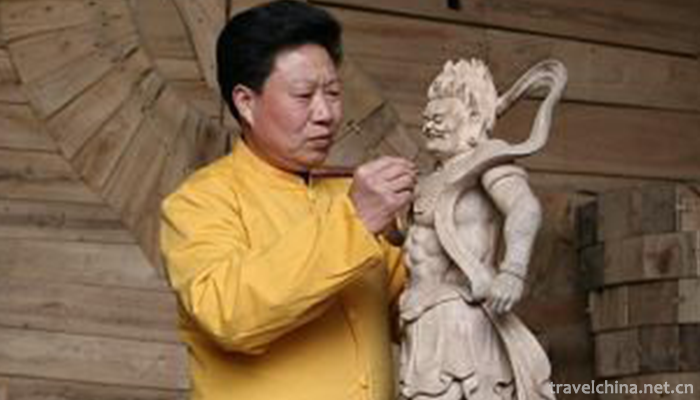
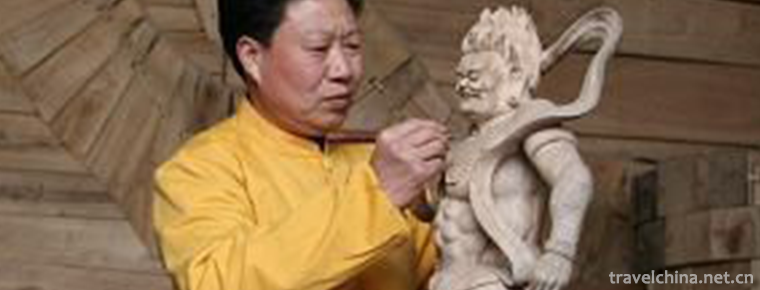
Skills of Dry Lacquer and Ramie in Tiantai Mountains
-
Pork intestine Noodles
Pork intestine Noodles are famous traditional snacks in Sichuan
Views: 239 Time 2018-10-12 -
Enshi Grand Canyon
Enshi Grand Canyon is located in Tunpu Township and Banqiao Township, Enshi City, Hubei Province. It is located at the junction of Hunan, Chongqing and Hubei provinces. It is the most beautiful sectio
Views: 185 Time 2018-12-12 -
Lushan National Forest Park
Located in the center of Shandong Province, Lushan National Forest Park is an important scenic spot of Boshan Scenic Tourist Area, with its main peak at 1108.3 meters above sea level, the highest peak
Views: 189 Time 2019-02-06 -
qingdao olympic sailing center
Qingdao Olympic Sailing Center Scenic Spot is located in Fushan Bay, Qingdao City, and Qingdao's landmark scenic spot - May 4th Square offshore, covering an area of about 45 hectares
Views: 264 Time 2019-02-07 -
Eight treasures Orange Cup
Babao Orange Cup is a delicacy. Its main ingredients are mushrooms, horseshoe, ham and chicken breast.
Views: 551 Time 2019-03-25 -
Dais Slow Wheel Pottery Technology
Dai Slow-wheel pottery, the primitive traditional handicraft of Yunnan, is one of the national intangible cultural heritages.
Views: 129 Time 2019-04-24 -
Fouriers Magic
Fu Tenglong, a national first-class actor and famous magic performer, is a member of the art team in the 1950s. Fu Tenglong was born in a magic family. He is an international magician who integrates p
Views: 359 Time 2019-05-04 -
Miao painting
Miao painting, as one of the representatives of Miao culture in Western Hunan, has the characteristics of Miao nationality and is mainly popular in the Miao area of Western Hunan. Miao painting origin
Views: 151 Time 2019-06-05 -
Bronze drum dance
Tonggu dance is one of the most popular and influential ancient dances among the Zhuang and Yi people in Wenshan Zhuang and Miao Autonomous Prefecture of Yunnan Province. It is distributed in Zhuang a
Views: 109 Time 2019-06-21 -
Xinjiang Uygur Mukam Art
Xinjiang Uygur Mukam Art is a large-scale integrated classical music art form which integrates singing, dancing and music. It is the general name of "Twelve Mukam" and "Daolang Mukam&qu
Views: 155 Time 2019-07-06 -
Firing Techniques of Yaozhou Kiln Ceramics
Yaozhou kiln is a treasure of Chinese traditional ceramic technology. It was created in the Tang Dynasty and matured in the Five Dynasties. It reached its peak in the Song Dynasty and declined gradual
Views: 189 Time 2019-07-11 -
University of Electronic Science and Technology Of China
Located in Chengdu City, Sichuan Province, the University of Electronic Science and Technology, formerly known as the Chengdu Institute of Telecommunication Engineering, was deployed by Premier Zhou E
Views: 202 Time 2019-08-31
